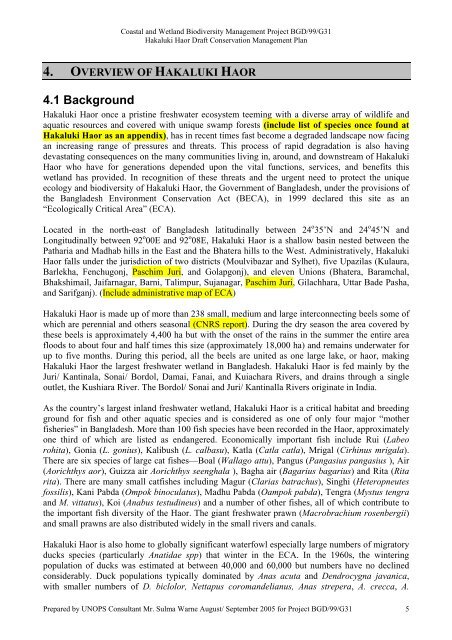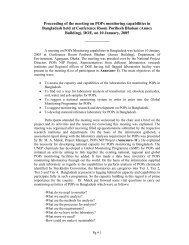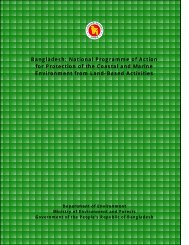Draft CMP HH - the Department of Environment
Draft CMP HH - the Department of Environment
Draft CMP HH - the Department of Environment
You also want an ePaper? Increase the reach of your titles
YUMPU automatically turns print PDFs into web optimized ePapers that Google loves.
Coastal and Wetland Biodiversity Management Project BGD/99/G31<br />
Hakaluki Haor <strong>Draft</strong> Conservation Management Plan<br />
4. OVERVIEW OF HAKALUKI HAOR<br />
4.1 Background<br />
Hakaluki Haor once a pristine freshwater ecosystem teeming with a diverse array <strong>of</strong> wildlife and<br />
aquatic resources and covered with unique swamp forests (include list <strong>of</strong> species once found at<br />
Hakaluki Haor as an appendix), has in recent times fast become a degraded landscape now facing<br />
an increasing range <strong>of</strong> pressures and threats. This process <strong>of</strong> rapid degradation is also having<br />
devastating consequences on <strong>the</strong> many communities living in, around, and downstream <strong>of</strong> Hakaluki<br />
Haor who have for generations depended upon <strong>the</strong> vital functions, services, and benefits this<br />
wetland has provided. In recognition <strong>of</strong> <strong>the</strong>se threats and <strong>the</strong> urgent need to protect <strong>the</strong> unique<br />
ecology and biodiversity <strong>of</strong> Hakaluki Haor, <strong>the</strong> Government <strong>of</strong> Bangladesh, under <strong>the</strong> provisions <strong>of</strong><br />
<strong>the</strong> Bangladesh <strong>Environment</strong> Conservation Act (BECA), in 1999 declared this site as an<br />
“Ecologically Critical Area” (ECA).<br />
Located in <strong>the</strong> north-east <strong>of</strong> Bangladesh latitudinally between 24 o 35’N and 24 o 45’N and<br />
Longitudinally between 92 o 00E and 92 o 08E, Hakaluki Haor is a shallow basin nested between <strong>the</strong><br />
Patharia and Madhab hills in <strong>the</strong> East and <strong>the</strong> Bhatera hills to <strong>the</strong> West. Administratively, Hakaluki<br />
Haor falls under <strong>the</strong> jurisdiction <strong>of</strong> two districts (Moulvibazar and Sylhet), five Upazilas (Kulaura,<br />
Barlekha, Fenchugonj, Paschim Juri, and Golapgonj), and eleven Unions (Bhatera, Baramchal,<br />
Bhakshimail, Jaifarnagar, Barni, Talimpur, Sujanagar, Paschim Juri, Gilachhara, Uttar Bade Pasha,<br />
and Sarifganj). (Include administrative map <strong>of</strong> ECA)<br />
Hakaluki Haor is made up <strong>of</strong> more than 238 small, medium and large interconnecting beels some <strong>of</strong><br />
which are perennial and o<strong>the</strong>rs seasonal (CNRS report). During <strong>the</strong> dry season <strong>the</strong> area covered by<br />
<strong>the</strong>se beels is approximately 4,400 ha but with <strong>the</strong> onset <strong>of</strong> <strong>the</strong> rains in <strong>the</strong> summer <strong>the</strong> entire area<br />
floods to about four and half times this size (approximately 18,000 ha) and remains underwater for<br />
up to five months. During this period, all <strong>the</strong> beels are united as one large lake, or haor, making<br />
Hakaluki Haor <strong>the</strong> largest freshwater wetland in Bangladesh. Hakaluki Haor is fed mainly by <strong>the</strong><br />
Juri/ Kantinala, Sonai/ Bordol, Damai, Fanai, and Kuiachara Rivers, and drains through a single<br />
outlet, <strong>the</strong> Kushiara River. The Bordol/ Sonai and Juri/ Kantinalla Rivers originate in India.<br />
As <strong>the</strong> country’s largest inland freshwater wetland, Hakaluki Haor is a critical habitat and breeding<br />
ground for fish and o<strong>the</strong>r aquatic species and is considered as one <strong>of</strong> only four major “mo<strong>the</strong>r<br />
fisheries” in Bangladesh. More than 100 fish species have been recorded in <strong>the</strong> Haor, approximately<br />
one third <strong>of</strong> which are listed as endangered. Economically important fish include Rui (Labeo<br />
rohita), Gonia (L. gonius), Kalibush (L. calbasu), Katla (Catla catla), Mrigal (Cirhinus mrigala).<br />
There are six species <strong>of</strong> large cat fishes—Boal (Wallago attu), Pangus (Pangasius pangasius ), Air<br />
(Aorichthys aor), Guizza air Aorichthys seenghala ), Bagha air (Bagarius bagarius) and Rita (Rita<br />
rita). There are many small catfishes including Magur (Clarias batrachus), Singhi (Heteropneutes<br />
fossilis), Kani Pabda (Ompok binoculatus), Madhu Pabda (Oampok pabda), Tengra (Mystus tengra<br />
and M. vittatus), Koi (Anabus testudineus) and a number <strong>of</strong> o<strong>the</strong>r fishes, all <strong>of</strong> which contribute to<br />
<strong>the</strong> important fish diversity <strong>of</strong> <strong>the</strong> Haor. The giant freshwater prawn (Macrobrachium rosenbergii)<br />
and small prawns are also distributed widely in <strong>the</strong> small rivers and canals.<br />
Hakaluki Haor is also home to globally significant waterfowl especially large numbers <strong>of</strong> migratory<br />
ducks species (particularly Anatidae spp) that winter in <strong>the</strong> ECA. In <strong>the</strong> 1960s, <strong>the</strong> wintering<br />
population <strong>of</strong> ducks was estimated at between 40,000 and 60,000 but numbers have no declined<br />
considerably. Duck populations typically dominated by Anas acuta and Dendrocygna javanica,<br />
with smaller numbers <strong>of</strong> D. biclolor, Nettapus coromandelianus, Anas strepera, A. crecca, A.<br />
Prepared by UNOPS Consultant Mr. Sulma Warne August/ September 2005 for Project BGD/99/G31 5





